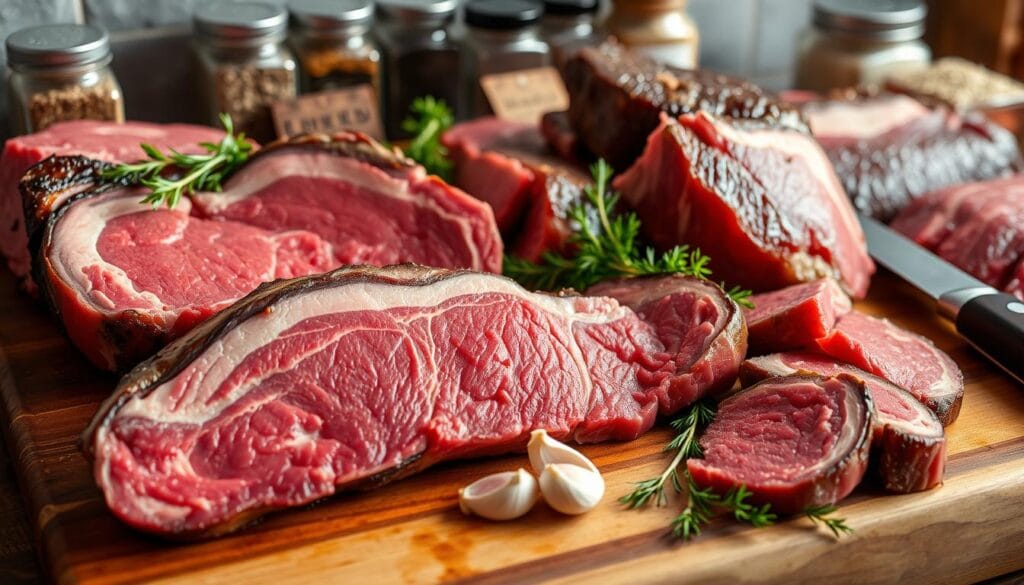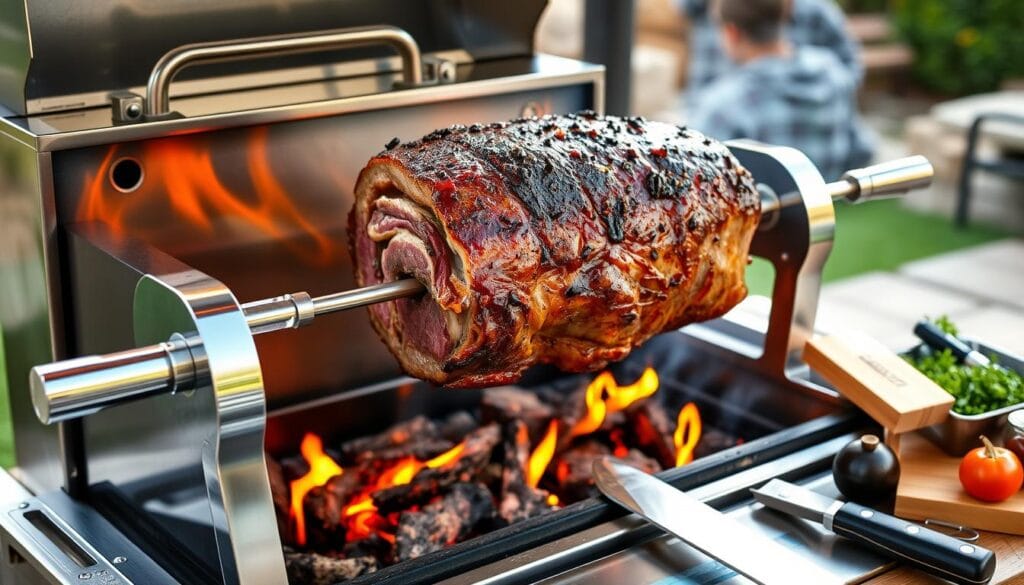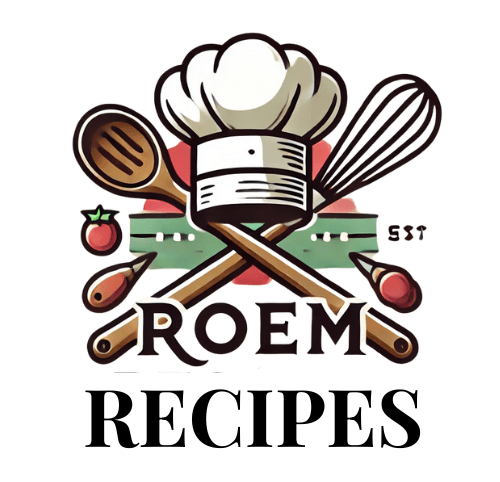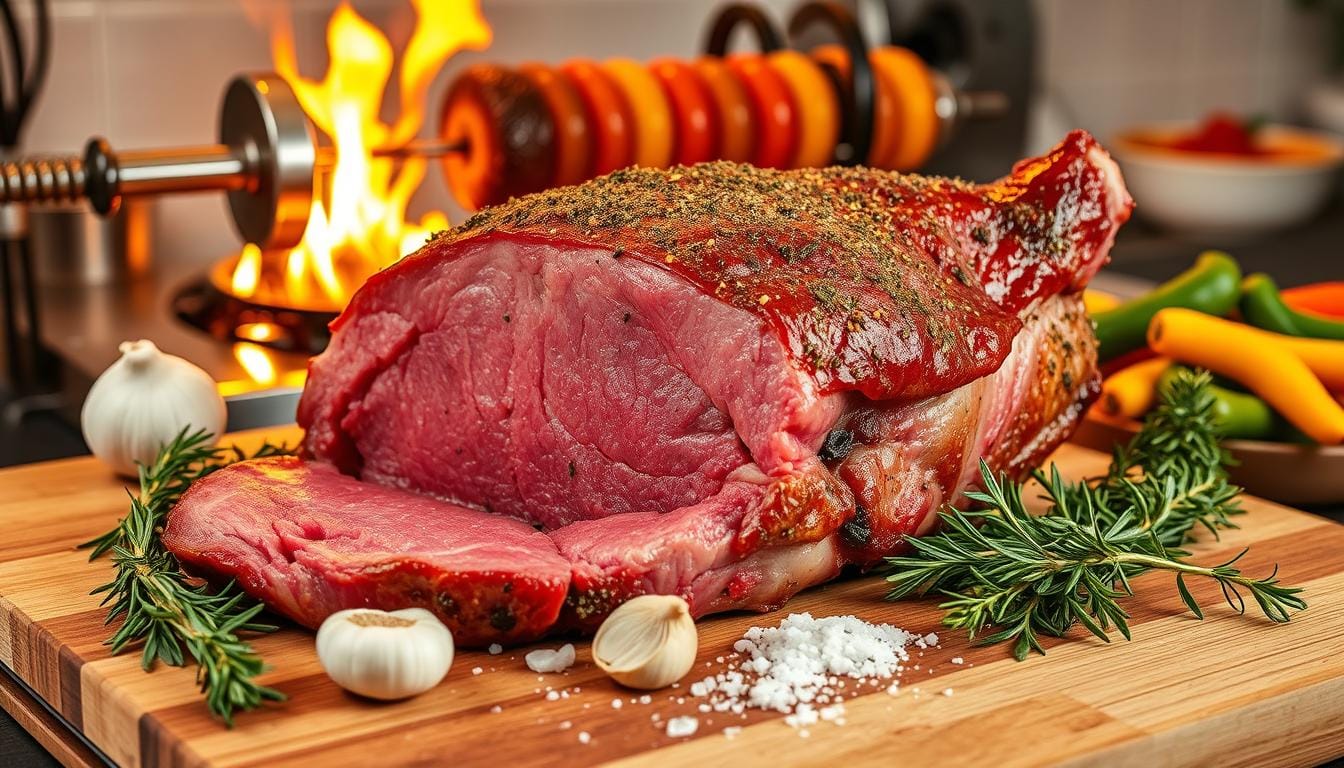Every family gathering has that special dish that makes the meal unforgettable. For me, a rotisserie prime rib roast is that dish. It’s a culinary masterpiece that gets everyone excited.
Cooking a prime rib roast on the rotisserie is more than just a method. It’s an art that promises amazing flavor and tenderness. Mastering this technique makes any meal special.
Whether it’s a holiday or a weekend celebration, this guide will help you make a memorable rotisserie prime rib roast. You’ll learn how to pick the right cut and get that perfect golden crust. It’s all about turning a simple dinner into a memorable feast.
The rotisserie prime rib roast’s magic is in its self-basting while it rotates. This ensures every slice is juicy and full of flavor. Get ready to impress your loved ones with an incredible meal.
Understanding Prime Rib: Cuts and Quality Selection
Choosing the right prime rib roast is key. You need to know about cuts, grades, and sizes. This knowledge helps make your meal unforgettable.

Prime vs Choice Grade Beef
Grade is important when picking a prime rib roast. The USDA has two main grades:
- Prime Grade: The highest quality with lots of marbling
- Choice Grade: Excellent quality but less marbling
“The difference in marbling can transform your dining experience from good to extraordinary.” – Culinary Expert
Bone-in vs Boneless Prime Rib Options
Choosing between bone-in and boneless prime rib changes the taste and how you cook it:
| Bone-in Prime Rib | Boneless Prime Rib |
|---|---|
| More intense flavor | Easier to carve |
| Typically 7 bones | More uniform shape |
| Loses about 30% weight during cooking | Shrinks approximately 20% |
Optimal Size Selection Per Person
When planning your prime rib roast, keep these serving tips in mind:
- Bone-in: Estimate 1 pound per person
- Boneless: Plan for 3/4 pound per person
- A four-bone roast typically serves eight people
Pro tip: Choose a roast with an even shape and a good fat cap. This ensures maximum flavor and juiciness.
Essential Equipment for Rotisserie Prime Rib
To make a delicious rotisserie prime rib, you need more than just great meat. The right rotisserie setup is key to getting that perfect, juicy taste. Knowing what equipment to use can make your cooking better and improve your skills.
Rotisserie Setup Requirements
For a great rotisserie prime rib, you need the right tools. Here are the main things you’ll need for a smooth cooking process:
- Rotisserie spit with compatible mounting brackets
- Heavy-duty rotisserie motor
- Sturdy meat forks for secure attachment
- Grill or outdoor cooking station with rotisserie attachment

Temperature Control Tools
Controlling the temperature is very important for your rotisserie prime rib. You should get these tools:
- Digital meat thermometer with probe
- Infrared surface temperature gun
- Multiple temperature monitoring devices
Additional Equipment Needs
To make your rotisserie cooking even better, think about these extra items:
- Heavy-duty aluminum drip pan
- Long-handled basting brush
- Insulated meat gloves
- Sharp carving knife and fork set
“The right tools can turn a good meal into an extraordinary culinary experience.”
| Equipment Category | Recommended Items | Average Cost Range |
|---|---|---|
| Rotisserie Basics | Spit, Motor, Forks | $100-$300 |
| Temperature Tools | Digital Thermometer, Probe | $50-$150 |
| Cooking Accessories | Drip Pan, Basting Brush | $30-$80 |
Your rotisserie setup is crucial for a successful prime rib roast. Good equipment means better results and helps you get better at rotisserie cooking.
Preparing Your Prime Rib for the Rotisserie
Rotisserie prime rib cooking needs careful steps. Start by picking the right cut and preparing it well. This ensures a meal that will be remembered.
Essential Preparation Steps
- Remove prime rib from refrigerator 2 hours before cooking
- Trim excess fat, leaving a thin layer for flavor
- Pat the meat dry with paper towels
- Bring meat to room temperature naturally
When preparing prime rib for the rotisserie, balance and stability are key. Make sure the roast is securely tied to the spit for even cooking.
Rotisserie Spit Mounting Technique
- Center the roast on the rotisserie spit
- Use sturdy butcher’s twine to tie the roast
- Ensure tight, even binding to maintain shape
- Check that the roast is balanced for smooth rotation
“Proper preparation is the secret to a restaurant-quality prime rib at home.” – Professional Chef
Rotisserie prime rib cooking requires precision. A well-prepared roast cooks evenly, bringing out rich flavors and a beautiful crust.
| Preparation Stage | Time Required | Key Action |
|---|---|---|
| Room Temperature Rest | 2 hours | Ensures even cooking |
| Trimming | 10-15 minutes | Remove excess fat |
| Spit Mounting | 15-20 minutes | Secure and balance roast |
By following these steps, you’ll prepare a succulent, perfectly cooked rotisserie prime rib. It will be the highlight of your meal.
Creating the Perfect Herb and Spice Crust
Turning your prime rib into a masterpiece starts with a great herb crust. The right seasoning can make your roast go from good to amazing. It turns a great piece of meat into a true culinary work of art.
The key to a fantastic herb crust is picking the right seasonings and using them just right. You want to make a flavorful outside that keeps the meat moist and adds to every bite.
Classic Seasoning Combinations
Professional chefs use tried-and-true herb mixes that match prime rib’s rich taste:
- Rosemary and garlic
- Thyme and black pepper
- Herbes de Provence blend
- Coarse sea salt and cracked pepper
Marinade and Rub Options
Seasoning for prime rib can be either dry rubs or wet marinades. Dry rubs make the outside crispy, while marinades soak the meat in flavor.
Application Techniques
To get the best herb crust for prime rib, follow these expert tips:
- Pat the meat dry with paper towels
- Apply a thin layer of olive oil
- Generously coat with seasoning
- Massage the herbs into the meat
- Let the seasoned roast rest for at least 2 hours before cooking
“The right seasoning transforms a good roast into an unforgettable dining experience.” – Chef Michael Roberts
Pro tip: For maximum flavor, apply your prime rib seasoning the night before cooking and let it rest uncovered in the refrigerator.
Rotisserie Prime Rib Roast Cooking Guide
Cooking prime rib on a rotisserie needs precision and attention to detail. This method ensures even cooking and brings out the meat’s full flavor.
To start, prepare your equipment well. The rotisserie prime rib cooking process involves these key steps:
- Preheat your grill to 250°F-275°F
- Set up indirect heat cooking zone
- Place a drip pan underneath the roast
- Secure the prime rib firmly on the rotisserie spit
The cooking time for rotisserie prime rib depends on the roast’s weight. Typically, plan for 15-20 minutes per pound. Always use a meat thermometer to check the internal temperature.
| Doneness Level | Internal Temperature | Cooking Time |
|---|---|---|
| Rare | 120-125°F | 15 minutes per pound |
| Medium Rare | 130-135°F | 17 minutes per pound |
| Medium | 140-145°F | 20 minutes per pound |
“The key to perfect rotisserie prime rib is patience and precise temperature control.” – Professional Barbecue Chef
Basting is key to keeping the meat moist during cooking. Make a herb garlic butter and baste the roast every 20-30 minutes. This will make the meat juicy and full of flavor, impressing your guests.
Temperature Guidelines and Cooking Times
Mastering prime rib cooking time and internal temperature is key to a perfect roast. It’s all about precise temperature control and timing.
Doneness Levels and Internal Temperatures
The internal temperature of your prime rib shows its doneness. Here are the temperature ranges to aim for:
- Rare: 120-125°F
- Medium-Rare: 130-135°F (most recommended)
- Medium: 140-145°F
- Medium-Well: 150-155°F
- Well-Done: 160°F and above
Time per Pound Guidelines
Cooking times depend on your desired doneness and roast size. Here’s a guide for the best results:
| Doneness | Temperature | Minutes per Pound |
|---|---|---|
| Rare | 120-125°F | 15 minutes |
| Medium-Rare | 130-135°F | 17 minutes |
| Medium | 140-145°F | 20 minutes |
Resting Period Importance
Patience is key after cooking. Let your prime rib rest for 15-20 minutes before carving. This step ensures a moist and flavorful roast.
“The secret to a perfect prime rib is not just in the cooking, but in the resting.” – Professional Chef
Always use a reliable meat thermometer to check the internal temperature. Remove the roast when it’s 5-10°F below your target. It will continue cooking while resting.
Basting and Moisture Maintenance Techniques
Keeping prime rib moist is an art that needs careful basting. Your rotisserie prime rib needs special care to stay juicy and full of flavor.
Basting prime rib is key to keeping it moist and preventing dryness. Chefs say to make a custom basting mix that boosts moisture and taste. Your basting liquid can include:
- Roast’s own drippings
- Melted butter
- Fresh herbs like rosemary and thyme
- Dry white wine or beef broth
The rotisserie’s constant motion helps spread the basting liquid well. Every 30-45 minutes, brush your prime rib well with the mix. This makes sure every part gets enough moisture and flavor.
“The secret to a perfect prime rib is not just in the seasoning, but in keeping it consistently moist during cooking.” – Professional Chef
Try making a special herb brush with fresh rosemary or thyme. It helps spread the basting liquid and adds more flavor to the meat.
| Basting Liquid Component | Flavor Profile | Moisture Impact |
|---|---|---|
| Beef Drippings | Rich, Meaty | High |
| Butter | Creamy, Smooth | Medium-High |
| White Wine | Acidic, Bright | Medium |
Your prime rib’s texture depends on regular, careful basting. By using these methods, you’ll make a rotisserie dish that looks great and tastes amazing.
Serving and Carving Your Prime Rib
Carving prime rib is an art that turns your roast into a memorable meal. The right techniques make your meal go from good to great. Each slice should be tender, juicy, and beautifully presented.
Mastering Carving Techniques
Here are the key steps for carving prime rib:
- Wait 15-20 minutes after cooking to let juices redistribute
- Use a sharp, long carving knife for precision
- Cut against the grain to maximize tenderness
- Aim for consistent slice thickness of ¾ inch
Presentation Tips for a Stunning Meal
Your prime rib needs a stunning presentation. Here are some serving tips:
- Place carved slices on a pre-warmed platter
- Garnish with fresh herbs like rosemary or thyme
- Serve with classic accompaniments:
| Accompaniment | Flavor Profile |
|---|---|
| Horseradish Sauce | Spicy, Sharp |
| Au Jus | Rich, Savory |
| Compound Butter | Herbal, Creamy |
“The difference between a good and great prime rib is often in the carving and presentation.” – Professional Chef
Pro tip for serving prime rib: Allow about one pound per person for bone-in roasts. For boneless cuts, use three-quarters of a pound. This way, everyone gets a satisfying portion of your perfectly prepared roast.
Conclusion: Mastering the Art of Rotisserie Prime Rib
Getting the perfect rotisserie prime rib is a journey of skill, patience, and passion. It’s about mastering temperature control, seasoning, and cooking methods. This turns a simple roast into a special dining experience.
Mastering prime rib cooking means paying close attention to every detail. It’s about experimenting with different ways to cook. Your rotisserie technique is key to a perfect prime rib.
The rotisserie method cooks the meat evenly. It makes the outside crispy and the inside juicy. Choose high-quality meat, season well, and check the internal temperature for the right doneness.
Practice is essential for rotisserie prime rib. Each try improves your skills and understanding of meat preparation. Soon, you’ll make prime rib that rivals restaurants.
Embrace the art of rotisserie cooking and let your creativity shine. Whether it’s for a holiday or a weekend dinner, your hard work will create unforgettable moments. These moments celebrate American barbecue traditions.


1 thought on “Perfect Rotisserie Prime Rib Roast: A Juicy, Flavorful Feast”